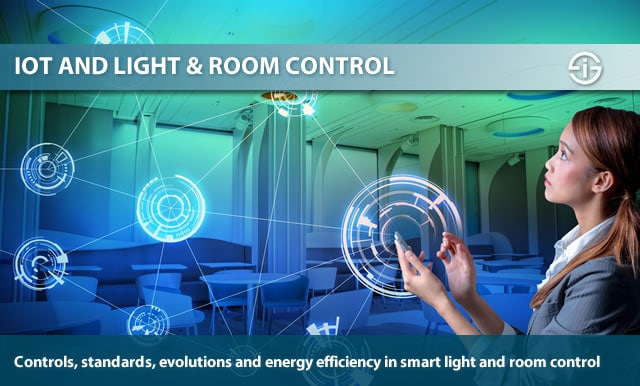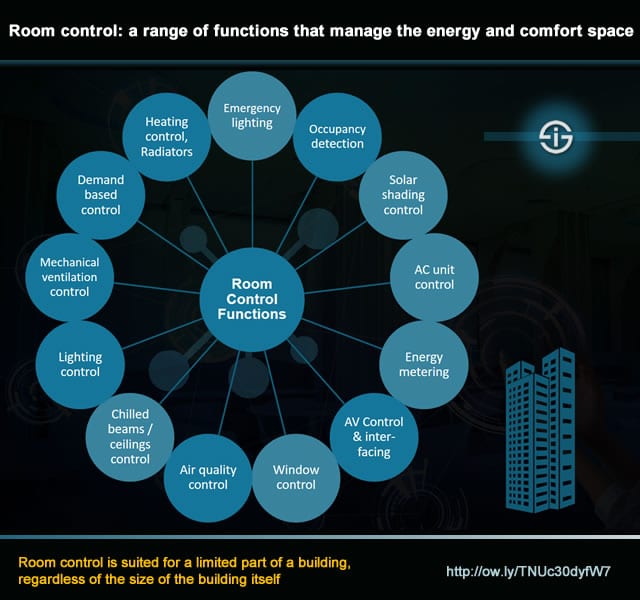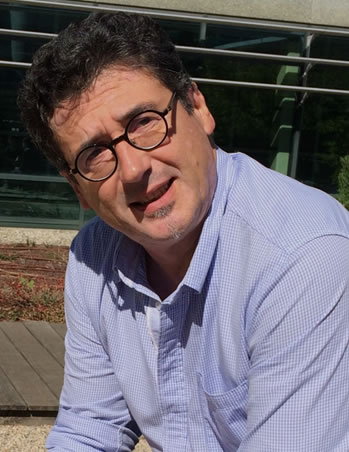Jean Commeignes, responsible for the L&RC certification badge in Schneider Electric’s partner program EcoXpert, takes us on a journey through the evolutions in lighting control, room control and building management systems in the age of IoT.

In our series on the evolutions in building management and energy efficiency in these times of Industry 4.0 and IoT, we looked at respectively connected power with IoT for small and medium enterprises, critical power in buildings with very specific energy demands (hospitals, airports etc.), the views of Martin Feder on building management and IoT and the role of channel partners and integrators across all these ecosystems.
The EcoXpert partner program of Schneider Electric and the expertise of its various badge owners were the common thread. A last – but certainly not least – area upon which we touch in this interview is lighting and room control.
Our guide is Jean Commeignes who is responsible for the light and room control training and certification badge within the EcoXpert program (the light and room control certification covers areas such as advanced home automation, lighting control and small building management systems).
As you will discover, light and room control is special in many regards, among others because it is ubiquitous in all sorts of buildings and in full flux amid the accelerating impact of IoT.
Jean, who is almost 30 years at Schneider Electric, has experienced the whole building management journey and the evolutions in building management systems and explains the evolutions and the future of L&RC in these times where IoT becomes ever more prominent.
Lighting and room control in residential and non-residential markets
Jean, the official description of business partners in the Light & Room Control space in EcoXpert is “proven expertise in deploying advanced home automation, lighting control and small building management systems, to improve comfort, increase energy savings and optimize efficiency through advanced user interfaces that offer simple control”. Can you elaborate?
Jean Commeignes: The EcoXpert Light & Room Control Badge is the only one that covers both residential and non-residential markets. It also has several touchpoints with the other certification programs. If you look at our offering you see three major domains: building management, power management and home automation.
IoT will gradually replace traditional communication networks such as BACnet by web services
Light & Room Control EcoXperts operate in both home automation and small & medium building automation, whose main focuses are lighting and temperature control, and integration with all possible monitoring & control devices and systems such as: audio/video, security, or energy management. The core of the Light & Room Control offering, consists of KNX and C-Bus systems.
However, they also operate in large buildings, by integrating their systems into building management systems.
The key role of KNX in green building certifications
If we look back at all the interviews, could we then say that L&RC goes together with building management systems, just as connected power goes hand in hand with critical power?
Jean Commeignes: Yes, it is exactly the same kind of situation, where solutions designed for Small & Medium buildings can integrate in systems dedicated to large or critical buildings.
There are the specialist L&RC systems which are advanced, high-end and offer total features at the top of the market, where you mainly find the KNX and C-Bus standards.
Despite the fact that with L&RC we are mainly in the small and medium enterprise and residential home automation market, the systems can be replicated for usage in larger buildings and are designed for integration with more complex systems, namely building management systems. So, that is a second connection between two badges in our certification program.
Building management systems are more generalist and from a lighting and room control perspective they don’t have the same specialist features.
For BMS system integrators this can be a problem when they want to reach high ratings in green building certification programs such as LEED (Leadership in Energy and Environmental Design) or BREEAM. These certification programs demand the KNX or C-Bus advanced lighting control levels as you go up in their rating for Gold or Platinum type of certifications. In this case a BMS EcoXpert will team up with a specialist L&RC EcoXpert.
Multi-badging: horizontal and vertical scenarios
This is why the multi-badge approach of the EcoXpert certification program is so important. There are several potential scenarios: horizontal and vertical.
So, in paving the way for the above described integration trend, BMS EcoXperts quite frequently decide to go for L&RC certification to master the full integrated solution.
At the same time, the connection between L&RC and connected power is horizontal in nature because both share the same target markets in the small and medium business space (keeping in mind that L&RC is residential too).
You can imagine that a connected power EcoXpert who is strong in electrical switchboards, power metering, and to deliver Smart Panels, sees the market opportunity of his customers increasingly demanding all-in-one smart systems. What could be more normal than to decide to go beyond the monitoring of electrical distribution and provide additional energy saving possibilities, with, on top, comfort by building automation, the essence of light and room control.

The definition of a room and the vast range of controls and technologies in lighting and room control
In the scope of the green building certifications you mentioned room control. Light and room control is one certification but consists of lighting control and room control. Can you elaborate?
Jean Commeignes: At the end of the day L&RC indeed aggregates these two areas with lighting control being needed for those BREEAM and LEED certifications and room control covering many building automation functions at the level of one or more zones.
Moreover, the notion of room control is important in the sense that it isn’t necessarily about the types of rooms that immediately come to mind such as a meeting room in a smart office or the rooms in a smart home. Room control is suited for a limited part of a building, regardless of the size of the building itself. Think about the lobby of a hotel, for example, or an open space in an office building.
Room control consists of a range of functions that manage the energy and comfort space. Typical room controls include functions such as lighting control, emergency lighting (which is required by regulation), occupancy detection, constant light and day light control, AC unit controls , solar shading controls and blinds control.
Room control is suited for a limited part of a building, regardless of the size of the building
You can categorize all these controls in clusters. Temperature control for instance includes blind control and the HVAC control. Or an air conditioning unit control can be part of energy control. On top of these logically combined clusters there are specialist monitoring and control areas such as air quality, energy metering or audio and video.
The reason why I emphasize this mix of various controls and the ways you can look at them as clusters is that you may have complex situations in room control.
For each of these controls and situations the EcoXpert needs to have the necessary skills and be able to ask questions such as the technologies that are in place and thus the structuring of the specific solution for a customer.
The scenario defines the required skillsets and the solution in what in the end is indeed a vast range of controls that can be very different from the perspective of the conditions, goals and technologies. If you just look at the different technologies to heat or to chill such as AC unit control, the chill beams, the radiators, the fan coils and so on, you see a mix of very different technologies whereby some are easy to manage and others require more specialization in HVAC.
The increasing role of asset management in buildings
Asset management has become the third pillar of light and room control. Asset management in L&RC can include chillers, boilers or heat pumps, as well as the entire power distribution installation, from the medium voltage down to the low voltage, or lighting installation
That is clear. Despite the many technologies and elements in L&RC, you said that energy efficiency and operational efficiency are two important parts of an L&RC value proposition. If we look at the most used IoT use cases in operations, asset management sticks out. Is that also the case in light and room control?
Jean Commeignes: Up to 5-10 years ago main focus was on two pillars: the comfort of users and the operational efficiency which was a mixture of energy saving and being efficient in operating and maintaining the building and its facilities.
With the rise of big data, the Internet of Things and other more recent technologies, asset management is becoming a third pillar. It enables the improvement of the lifetime of key equipment, makes sure that it operates in the best possible way and results in an optimal return on investment.
In the EcoXpert world assets can include chillers, boilers or heat pumps, as well as the entire power distribution installation, from the medium voltage down to the low voltage, or lighting installation. In the example of power distribution infrastructure, switch gear embedded metering will enable to monitor for example their wear, and accurately plan replacement budgets.
Thanks to the DALI specialist lighting communication network, each luminaire is individually monitored, enabling to plan not only relamping campaigns, but also orienting lighting technology orientations, given revolutionary sea changes in this industry.
We focus both on reactive and on predictive maintenance whereby everything depends on the requirements of the customer, the value of the assets and of course the budget choices which can vary over time.
The Light and Room Control ecosystem
What types of companies are typically involved in the L&R EcoXpert badge?
Jean Commeignes: The two main ones are electrical contractors and system integrators. Yet, there are differences, among others with regards to the country.
In Germany, for instance, an electrical contractor is KNX trained at school and, even at the lowest level, has some KNX skills. In Southern Europe this is not the case and here we see electrical contractors going for specialization to rise above their commoditized market. Others, again depending on country, seek more expertise and differentiation in home automation or even industrial automation. Electrical contractors typically prefer simpler solutions with open technologies as we offer them.
A main scope of IoT for light and room control is home automation with endless applications in the present and a near future: from heating or air conditioning control to lighting control, reinforced by the LED revolution, to all possible applications which fit end customer needs
System integrators are born to customize, integrate and develop software. They sometimes work directly with end customers or provide their integration and commissioning expertise to electrical contractors. While they typically offer high degrees of customization and tailor-made solutions they are extremely challenged on implementation time so they need in same time efficiency of pre-configured systems and customization resources.
The main end customer segments are the high-end residential home market, small and mid-size commercial buildings and when integrated in BMS, as I explained previously, large commercial buildings. Here as well we see regional differences in the end customers and the types of partners serving them.
Light control and room control standards and the game-changing role of IoT
A final question: your L&RC solutions support bus technologies such as KNX, C-BUS, DALI and IP. How would you position them and what is the role of IoT in it all and in the future of the EcoXpert program?
Jean Commeignes: KNX is an open system, mainly used in Europe, Middle East, now gaining in Asia Pacific and Latin America. C-BUS is a lighting control specialist system, mainly used in the Asia Pacific region, but also in Middle East, and UK / South Africa
DALI is an open lighting specialist communication technology, especially fitting small and medium buildings, or to be integrated into larger KNX or C-BUS systems.
As everything is now IP, it is clear that we and our EcoXpert partners support that too. As far as concerns the Internet of Things, the L&RC partner acts as an integrator of everything at the IoT level.
If all markets are impacted by the Internet of Things, a main scope for L&RC is without any doubt in home automation with endless applications in the present and a near future: from heating or air conditioning control to lighting control, reinforced by the LED revolution, to all possible applications which fit end customer needs.
A first of such applications is in security and audio video systems but also take into account energy monitoring, watering, swimming pools, wine cellars, fridges and even aquariums. The list is really endless and it will grow exponentially over time with individual connected devices, validated multifunctional systems, which are pre-engineered bundles of repetitive applications.
The impact on the EcoXpert program is clear: IoT leads to various streams of multi-badging with a full complementarity between L&RC and connected power in the mid-market and L&RC going with BMS in large buildings.
In this BMS space, IoT will gradually replace traditional communication networks such as BACnet by web services and closely imbricate with Internet oriented languages for software customization.
Thanks Jean for your time and insights!
Disclaimer: we deliver services to Schneider Electric’s EcoXpert program, including content services. Top image: Shutterstock – Copyright: chombosana


